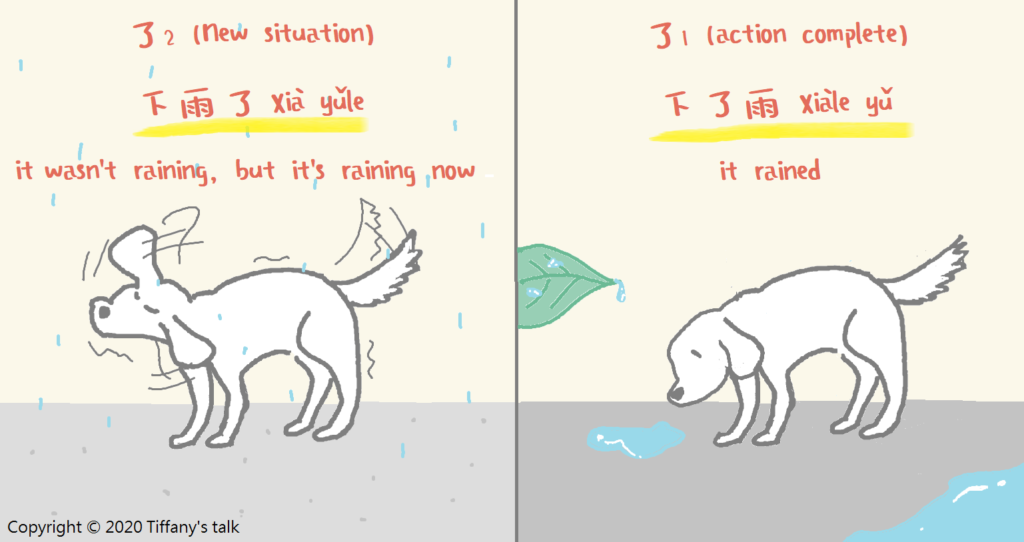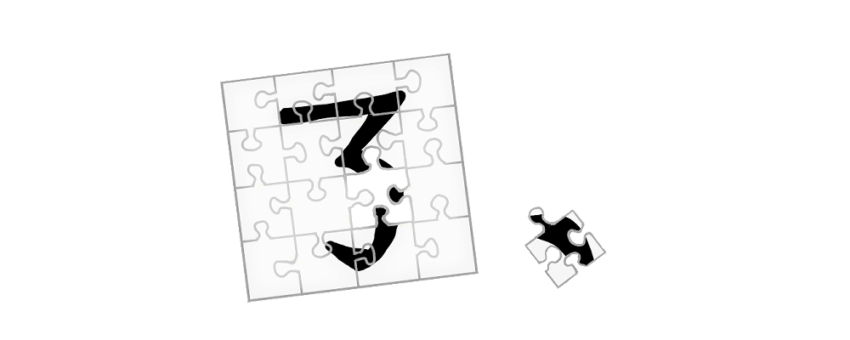Grammar Point:
Some textbooks may list multiple meanings to explain the Chinese character 了 le, but actually, there are only three of them main uses which we refer 了1, 了2, and 了3.
了1 (Verb-suffix了)
S + V + 了 + (O)
It means the action is complete and it should always be placed immediately after the verb.
Here comes the tricky part. Is using 了1 equivalent to the past tense in English?
The answer is NO! There is no past tense in Chinese. But we use “le” to indicate a completed action. Therefore, there are some cases where we would use past tense in English, but we don’t use “le in Chinese. For example, “I didn’t eat it” is past tense in English, but the action isn’t really finished. You didn’t eat the food, so we don’t use “le” in Chinese. Therefore, please do not link 了1 with past tense.
There are other verbs that we never use “le” with because they cannot be completed. For example, “love” can’t be completed. So we never use “le” with it in Chinese.
他吃了飯他吃了饭
He had a meal. (It emphasizes the action of eating has been completed.)
我睡了覺我睡了觉
I slept. (It emphasizes that I am currently awake since I have completed the action of sleeping.)
我明天下了課就要回家我明天下了课就要回家
I’m going home tomorrow right after finish the class.
(This is another good example showing that 了 le is not a past tense marker. )
Add more details with 了1
S + V +了1 + Number + Measure Word + O
他昨天吃了兩碗飯他昨天吃了两碗饭
He ate two bowls of rice yesterday.
我喝了五杯水我喝了五杯水
I drank 5 glasses of water.
老師給了你5塊錢嗎?老师给了你5块钱吗?
Did the teacher give you five dollars?
S + V +了1 + Time spent + (的 de + O)
他晚上看了兩個鐘頭的電視他晚上看了两个钟头的电视
He watched two hours of television at night.
他跟他男朋友交往了七年他跟他男朋友交往了七年
He was in a relationship with his boyfriend for seven years.
你以前在台灣學了多久的中文?你以前在台湾学了多久的中文?
How long did you study Chinese in Taiwan before?
Something you may wonder
你吃了飯嗎?你吃了饭吗?
This is not commonly used because it doesn’t mean ‘Have you eaten?’ Instead, it means ‘Have you finished your eating action?’ As you can tell, it is not a very natural sentence to use. However, if we add a second action after it, then it would be appropriate. It indicates that after completing the first action, you will perform the second action.
你吃了飯要一起去打球嗎?你吃了饭要一起去打球吗?
Are you going to play ball together after dinner?
了2 (Sentence particle了)
S + V + (O) + 了2
It indicates a new situation or change of state and is always placed at the end of a sentence.
The Chinese particle 了2 is typically used at the end of a sentence to indicate a change of state or situation, except when a final particle (such as ma, ba, a, ne, etc.) is present. In such cases, it appears immediately before the final particle. The 了2 particle emphasizes that the situation is now different from before and that there has been a change in the state of something.
王先生五年前很胖,現在瘦了王先生五年前很胖,现在瘦了
Mr. Wang was fat 5 years ago but now he is thinner.
學中文的人多了学中文的人多了
The number of people who are learning Mandarin is increasing a lot.
(It wasn’t like that before.)
東西都貴了东西都贵了
Things are getting expensive now. (They were inexpensive before)
我飽了!我饱了!
I am full. (I was hungry)
我不愛你了!我不爱你了!
I don’t love you anymore. (I used to love you in the past)
Questions
你喝咖啡了嗎?你喝咖啡了吗?
Have you had coffee?
(It implies that you know this person drinks coffee and you want to check whether the statement ‘drink coffee’ has changed or not yet.)
你付錢了嗎?你付钱了吗?
Have you paid?
Let’s compare these 5 sentences!
你喝咖啡嗎?你喝咖啡吗?
你喝了咖啡嗎?你喝了咖啡吗?
你喝咖啡了嗎?你喝咖啡了吗?
你要喝咖啡嗎?你要喝咖啡吗?
你在喝咖啡嗎?你在喝咖啡吗?
The first question is asking about whether or not the person drinks coffee. It doesn’t imply anything specific. The second sentence is asking if the person has finished their coffee. It implies that the action of drinking coffee has already taken place, and the speaker is asking whether or not the person has completed it. The third sentence is asking if the person has had coffee. It emphasizes whether or not the action of drinking coffee has happened in the past. The fourth sentence is a question about whether or not the person wants to drink coffee in the present or near future.The last question is asking about the person’s current activity, specifically if they are currently drinking coffee.
了3 (Set了)
太 tài + SV + 了 le / SV + 死了 sǐle
This is a fixed structure in the language and does not convey any specific meaning.
The 了3 particle in Chinese is the simplest one. It is used in a few fixed structures that you just need to memorize.
天氣熱死了!天气热死了!
The weather is too hot.
王先生太胖了!王先生太胖了!
Mr. Wang is too heavy!
Let’s Try Out
Let’s try to compare these two sentences!
下雨了 Xià yǔle VS 下了雨 Xiàle yǔ
Do you know the difference?

了 Part 1
Want to know more usages of 了?
Check this article:了 Part 2


